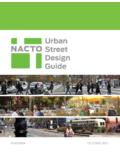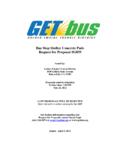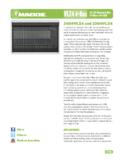Transcription of Accessible bus stop design guidance - Transport …
1 MAYOR OF LONDONT ransport for LondonAccessible bus stop design guidanceBus Priority Team technical advice note BP1/06 January 2006 Accessible bus stop design guidanceFurther information For further details or advice on the design of Accessible bus stops, contact:Bus Priority TeamTransport for LondonWindsor House, 42-50 Victoria StreetLondon, SW1H 0 TLTel 0845 300 7000 Website: for London | Accessible bus services .. stop locations .. waiting area .. stop stop layouts .. bays .. profiles and heights .. bus stop improvements .. term issues ..50 List of figuresFigure 1: Features of the bus stop 2: Passenger groups benefiting from low floor buses ..4 Figure 3: bus stop layout objectives ..6 Figure 4: Relationships between bus and kerb ..7 Figure 5: Considerations for bus stop locations ..9 Figure 6: Bus arrival 7: bus stop location in vicinity of traffic signals fitted with SVD.
2 13 Figure 8: Boarding and alighting 9: Boarding and alighting zones Alternative shelter arrangement ..18 Figure 10: Passenger waiting area critical 11: Kerbside stop with parking on approach and 12: Exit side of pedestrian crossing ..27 Figure 13: Exit side of junction ..28 Figure 14: Full width boarder ..32 Figure 15: Alternative full width boarder 16: Multiple bus full width boarders ..34 Figure 17: Half width boarder ..37 Figure 18: Angled boarders ..38 Figure 19: Bus bay arrangements ..41 Figure 20: Amendment to existing bus bay ..42 Figure 21: Special kerbs ..45 Figure 22: Flow chart of potential tasks for improving bus stops ..47 Figure 23: Gantt chart of standard tasks for improving bus stops ..48 Figure 24: Bus dimensions ..52 AppendicesAppendix A: Bus measurements ..51 Appendix B: Effects of introducing bus boarders ..54 Appendix C: Effects of removing bus lay-bys ..56 Appendix D: Special E: Worked examples.
3 592 Accessible bus stop design guidance1. IntroductionThis guide updates the bus stop Layouts forLow Floor Bus Accessibility published in June2000 and its predecessor documents. It alsoincorporates advice developed for theintroduction of articulated buses, published byTransport for London (TfL) in April 2002. Theseupdated guidelines have been developed in thecontext of the Government's policies onintegrated Transport , the Mayor s TransportStrategy, and the Disability Discrimination Act is intended that this guide will assist highwayauthorities in the development of practical andaffordable measures to improve accessibility atbus stops. The measures should becompatible with the particular characteristicsof buses deployed on London s road introduction of low floor busesthroughout London, fitted with ramps forwheelchair users, has led to a requirement forappropriate kerbside access at bus all stops along a bus route are equallyaccessible, passengers may be unable to boardor alight a bus at their desired location and thepotential benefits from low floor buses will bereduced.
4 This hinders the development of aninclusive public Transport stop design and location is recognised as acrucial element in the drive to improve thequality of bus services. The concept of 'TotalJourney Quality' recognises that bus passengersare also pedestrians at each end of the bus tripand requires that all aspects of the journey areconsidered. The convenience and comfort ofbus stops must not be is important to view the bus stop as aninterchange, rather than simply a location along a bus route where buses stop,comprising only a post with a flag, and a cagelaid on the road surface. The bus stop environment contains a numberof features that need to be considered, asillustrated in Figure fully Accessible bus service is a criticalelement in delivering a fully inclusive stops are a vital link in this vision. TfLwishes to highlight this, and part of therationale in revising the bus stop designguidelines is to reiterate the wider issuesrelating to equality and inclusion.
5 Furthermore,it should be remembered that kerbsidecontrols and bus boarders are merely tools the objective is to ensure that the bus stop isfully for London | 3 Additionally, it is important to emphasise theneed for: training for bus drivers on how to approachand correctly use the bus stop ; planners and engineers to optimise thelocation, design and construction of busstops; and motorists and enforcement authorities torecognise the necessity for bus stops to bekept clear of parked reviewing individual bus stops, and theirimmediate environs, designers need to takeaccount of the wide range of issues that arediscussed within this guide . Whilst theseguidelines provide assistance with the decisionmaking process, it should be recognised thateach site is a unique location, with differentcharacteristics to be taken into stopenvironmentSecurity,including lightingConveniencefor passengersConnectivitywith footwaysApproach and exitpaths for busesSpace forstraighteningPosting andnumber of berthsAdequacyof platform(waiting area)Type andheight of kerbTicketmachinesPedestrianfootwayDrain ageInformation(includingmaps etc.)
6 Position of utilities'access covers andstreet furnitureBus passengershelter and seatingSurface markingsfor busesand passengersBus stoppost and flagFigure 1: Features of the bus stop environment4 Accessible bus stop design guidance2. Fully Accessible bus servicesLow floor bus usersLow floor buses reduce the height differentialbetween the kerb and bus floor. Whilst theyare generally seen as a means of improvingaccessibility for passengers with disabilities,including wheelchair users, all passengersbenefit from low floor bus services, asillustrated in Figure conducted by Transport ResearchLaboratory (TRL Report 271) has shown thatpassengers with pushchairs benefit greatlyfrom the introduction of low floor , when designing bus stops for low floorbus access, the needs of all passengers shouldbe considered, not just wheelchair of London s bus servicesThe entire TfL bus network is now operatedusing low floor vehicles, which have a singlestep entry, a low floor in the front part of thevehicle, and either a sloping gangway, or steptowards the rear, over the drive axle.
7 Generally,they have front doors for boarding passengersand centre doors for those floorbus accessbenefits:People withyoung childrenPeople withpushchairsAmbulantdisabledpeoplePeop le withimpaired visionWheelchairusersPassengers withshopping or luggageElderly peopleFigure 2: Passenger groups benefiting from low floor busesTransport for London | 5 Powered ramps are usually fitted at the centredoor where wheelchair users may board andalight. Push buttons are provided forwheelchair users to alert the driver when theramp needs to be deployed. Additionally, lowfloor buses are provided with the means oflowering, or kneeling the bus suspension toreduce the step height at London, there are a number of busconfigurations in operation, which need to beconsidered. Flexibility should be provided indesigns in recognition that bus types using astop may change as a result of service example, articulated bus operation hasbeen introduced on several high volumeservices and passengers are able to board andalight through all three sets of doors.
8 The images below show typical busconfigurations currently operating on London sroads. Appendix A provides details anddimensions of the standard rigid andarticulated buses used to develop the layoutsin this busSingle deck busDouble deck busArticulated bus6 Accessible bus stop design guidanceBus stoplayoutobjectivesAllow easyunobstructedaccess to and fromthe stopMinimise timespent at the busstop by the busPrevent/dissuadeother vehicles fromparking in the stop areaAllow the busto line up within50mm of and parallelwith the kerbMinimise useof kerb space wherethere are competingdemands for frontageaccessAffordable andcommensurate with theaccessibility benefitRemove streetfurniture which preventspassengers boardingand alightingBus stop layout objectivesThe ideal bus stop layout will achieve theobjectives shown in Figure 3. The bus shouldstop parallel to, and as close to the kerb aspossible to allow effective use of the bus facilities.
9 The critical dimensions (see ) to consider are the vertical gap, or stepheight, from the kerb to the bus floor and thehorizontal gap from the kerb edge to the sideof the bus. A well designed bus stop willprovide features which co-ordinate with thefacilities of the low floor bus and minimisethese two size of the vertical gap between the kerband floor of the bus will affect the gradient ofthe ramp when it is deployed (see Figure ).If this gradient is too severe, some wheelchairusers may be unable to enter or exit safelyfrom the bus. Regulations under the DisabilityDiscrimination Act 1995 (DDA) require newbuses to be capable of deploying a ramp,giving a 1:8 or 12 percent (7 degree gradient),onto a kerb of at least 125mm in height. This regulation, therefore, assumes a'standard' kerb height of 125mm, which,although not the case universally, is the heightthat vehicle manufacturers are guided to applyin bus 3: bus stop layout objectivesTransport for London | 7 Figure 4: Relationships between bus and kerbFigure : Critical dimensionsFigure : Ramp gradientFigure : Normal step heightFigure : Kneeling step heightIt is important to recognise that, even when deployed on a 125mm high kerb, thegradient of the ramp may vary.
10 The majordeterminants include: type of ramp; ramp length; carriageway and footway crossfalls; distance of the bus from the kerb; kneeling height of the bus floor (seeFigures and whether the bus is laden. The use of a 140mm maximum kerb height, or higher special kerbs (see Chapter 9), arepreferred as they result in lower ramp FloorKerbNew stepheightReduction from originalstep heightRoad LevelBus FloorKerbStepHeightRoad LevelBus FloorRampRamp GradientKerbRoad LevelBus FloorKerbVerticalGapHorizontalGapKerbHei ghtRoad Level8 Accessible bus stop design guidanceIt should be noted that with the kneeling systems in common use, the reduction in stepheight achieved is not necessarily uniform alongthe side of the bus. The front door will be lowerthan the centre door if the kneeling systemoperates on the front axle alone. Alternativeconfigurations include tilting of the nearside ofthe bus and lowering of the entire the urban environment, there often exists aconflict between the demands for frontageservicing, short term parking and the need toprotect a sufficient length of kerb space toallow buses to easily access a stop.)







